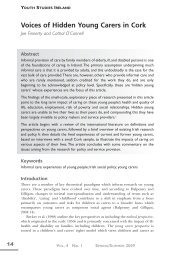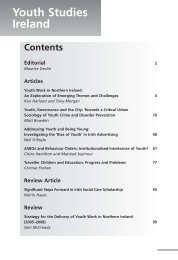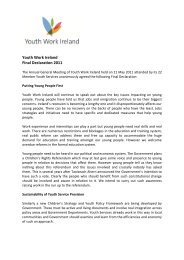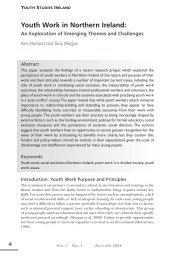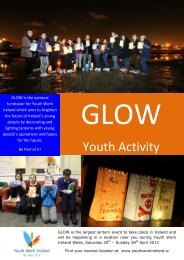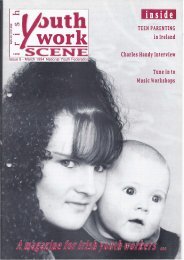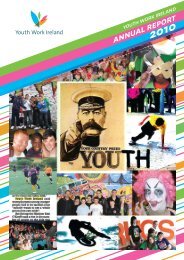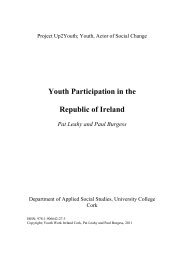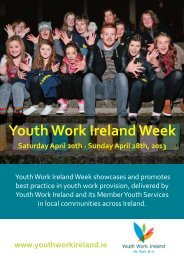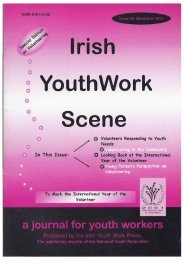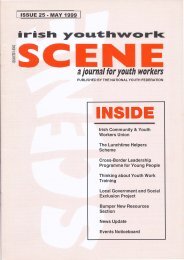Issue 31: March 2001 - Youth Work Ireland
Issue 31: March 2001 - Youth Work Ireland
Issue 31: March 2001 - Youth Work Ireland
You also want an ePaper? Increase the reach of your titles
YUMPU automatically turns print PDFs into web optimized ePapers that Google loves.
ResourcesESTAT E-BASED WORKWITH YOUNG PEOPLEInvesting in People: The Labour Market Impact ofHuman Resource Interventions Funded Under the1994-1999 Community Support Framework in <strong>Ireland</strong>(Policy Research Series, No. 38, November 2000)By Kevin Denny, Colm Harmon & Philip J. O'ConnellExpenditure on human resource development representsa very large and important component of publicexpenditure and represented about one-third of totalEuropean Union aid to <strong>Ireland</strong> under the 1994-1999Community Support Framework (CSF). The mainobjectives of CSF was to boost human capitalenhancing education and skills levels and to enhance theemployment prospects of unemployed people.The Irish Department of Finance and the EuropeanCommission decided in 1998 to commission a study ofthe labour market impact of the education and trainingprovisions across the CSF.byThe main aim envisaged forthe study was to produce, as far as possible, quantifiedestimates of the net impact of interventions fu nded underthe CSF on the labour market outcomes of participantsand target groups.The present study focuses exclusively on the labourmarket impact of human resource interventions and itshould be acknowledged that such programmes may alsoserve other objectives in preparing citizens for fu llparticipation in the economy and society.The review ofdevelopments in the labour market during the 1990's,shows clearly the labour market conditions weretransformed over the course of the 1994-1999Community Support Framework.Over that brief periodthe booming economy led to a shift from massunemployment to labour shortages.<strong>Youth</strong>agenda: a Good Practice Guide to workingwith young people on their home ground.By the Guinness Trust Group & Centre for SocialAction<strong>Youth</strong>agenda is a practical handbook to help all thosewho come into contact with young people. It is especiallyfor estatemanagers, housing officers, tenants andresidents associations (TRA's) who work with youngpeople on their home ground. Its aim is to help direct theirenergy and enthusiasm towardsaspects of their lives.improving specificIn ru nning their estates, social landlords may overlook thecontribution that young people can make because theyare rarely involved in fo rmal community activity.Landlords and tenants groups need to find ways ofturning their contribution into positive practical action.recognises that young people have concerns andpriorities which may not necessarily coincide with those ofestate managers.One cannot impose this agenda forchange; it must come from young people's own choosing.De Montfort University's Centre for Social Action hasdeveloped a proven process which involves andmotivates young people by working with them.ItThishandbook shows how the process was implemented onthree estates, to what degree it worked and how one canapply the process to your own environment. Thehandbook offers the means for RSL's to work with youngpeople and to help them influence the quality of life in theircommunities.Skills acquired through Social Action willhelp young people continue to be active as they becomeadult residents.In the new scenario human resource interventionscontinue to play a vital role in meeting skill needs. Ininitial education, continued investment is essential toprepare young people for labour market entry and tomatch the growing demand for skilled workers. In labourmarket policies targeted at the unemployed, effectiveprogrammes can both enhance the employmentprospects of those experiencing difficulty in the labourmarket and ease skill and labour shortages in thebooming economy.Information Management for Voluntary & CommunityOrganisationsBy Paul Ticher & Mike PowellSuccessful organisations use information effectively tosupport their activities by managing it as a positiveresource. Starting from basic principles, this nononsenseguide for managers and their teams is packedwith practical tools and tips to help readers:Irish <strong>Youth</strong><strong>Work</strong> Scene<strong>March</strong> <strong>2001</strong>



